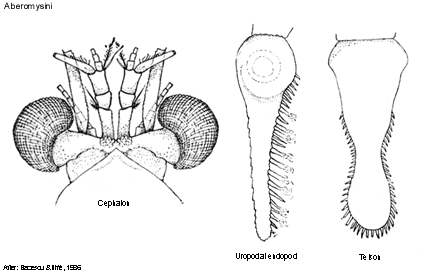 |
||||||
|
|
|
|
|
|
Mysidacea: Families, Subfamilies and TribesKenneth MelandAberomysini Bacescu & Illife, 1986 Diagnostic description. Head. Carapace large, last 2 or 3 thoracic somites exposed dorsally. Rostrum obtuse. Eyes normally developed. Antenna (antenna 2) scale without apical suture, outer margin smooth, without setae, with terminal spine. Labrum symmetric. Mandible lacinia mobilis well developed, spine row present between lacinia mobilis and molar process, molar process well developed. Thorax. 1st maxilliped exopod absent, or well developed. 2nd thoracopod developed as a maxilliped, exopod well developed. 3rd-8th thoracopods endopod with fused carpus and propodus (tarsus), carpopropodus divided into a few subsegments. Branchiae on thoracopods absent. Marsupium composed of two pairs of oostegites. Abdomen 6th & 7th abdominal somites fused. 1st pair endopod reduced; 2nd pair biramous; 3rd pair biramous; 4th pair biramous; 5th pair biramous (exopod three times longer than endopod). Female pleopods uniramous or greatly reduced. Uropod endopod inner margin with robust setae, statocyst present; exopod complete, setose around entire margin. Telson apex entire, or lateral margins constricted. Generic composition. Aberomysini contains 1 genus (1 species): Aberomysis muranoi Bacescu & Illife, 1986. Remarks. The tribe Aberomysini is monotypic, described from marine caves on the Palau Islands. This mysid is easily recognized by it's large brown eyes and bright white integument.
Cite this publication as: 'Meland, K. (2002 onwards). Mysidacea: Families, Subfamilies and Tribes. Version 1: 2 October 2002. https://crustacea.net'. |
|
|
|
|
|
|
|
|
|
Copyright © Australian Museum, 2002 - 2003
Australian Museum website
